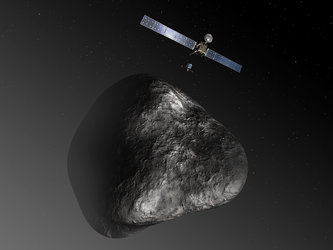Accept all cookies Accept only essential cookies See our Cookie Notice

About ESA
The European Space Agency (ESA) is Europe’s gateway to space. Its mission is to shape the development of Europe’s space capability and ensure that investment in space continues to deliver benefits to the citizens of Europe and the world.
Highlights
ESA - United space in Europe
This is ESA ESA facts Member States & Cooperating States Funding Director General Top management For Member State Delegations European vision European Space Policy ESA & EU Space Councils Responsibility & Sustainability Annual Report Calendar of meetings Corporate newsEstablishments & sites
ESA Headquarters ESA ESTEC ESA ESOC ESA ESRIN ESA EAC ESA ESAC Europe's Spaceport ESA ESEC ESA ECSAT Brussels Office Washington OfficeWorking with ESA
Business with ESA ESA Commercialisation Gateway Law at ESA Careers Cyber resilience at ESA IT at ESA Newsroom Partnerships Merchandising Licence Education Open Space Innovation Platform Integrity and Reporting Administrative Tribunal Health and SafetyMore about ESA
History ESA Historical Archives Exhibitions Publications Art & Culture ESA Merchandise Kids Diversity ESA Brand CentreLatest
Space in Member States
Find out more about space activities in our 23 Member States, and understand how ESA works together with their national agencies, institutions and organisations.
Science & Exploration
Exploring our Solar System and unlocking the secrets of the Universe
Go to topicAstronauts
Missions
Juice Euclid Webb Solar Orbiter BepiColombo Gaia ExoMars Cheops Exoplanet missions More missionsActivities
International Space Station Orion service module Gateway Concordia Caves & Pangaea BenefitsLatest
Space Safety
Protecting life and infrastructure on Earth and in orbit
Go to topicAsteroids
Asteroids and Planetary Defence Asteroid danger explained Flyeye telescope: asteroid detection Hera mission: asteroid deflection Near-Earth Object Coordination CentreSpace junk
About space debris Space debris by the numbers Space Environment Report In space refuelling, refurbishing and removingSafety from space
Clean Space ecodesign Zero Debris Technologies Space for Earth Supporting Sustainable DevelopmentLatest
Applications
Using space to benefit citizens and meet future challenges on Earth
Go to topicObserving the Earth
Observing the Earth Future EO Copernicus Meteorology Space for our climate Satellite missionsCommercialisation
ESA Commercialisation Gateway Open Space Innovation Platform Business Incubation ESA Space SolutionsLatest
Enabling & Support
Making space accessible and developing the technologies for the future
Go to topicBuilding missions
Space Engineering and Technology Test centre Laboratories Concurrent Design Facility Preparing for the future Shaping the Future Discovery and Preparation Advanced Concepts TeamSpace transportation
Space Transportation Ariane Vega Space Rider Future space transportation Boost! Europe's Spaceport Launches from Europe's Spaceport from 2012Latest

First spacecraft to Rendezvous with a comet
Thank you for liking
You have already liked this page, you can only like it once!
First spacecraft to Rendezvous with a comet
After a decade long journey chasing its target, ESA’s Rosetta has become the first spacecraft to rendezvous with a comet, opening a new chapter in Solar System exploration.
Since its launch in 2004, Rosetta made three flybys of Earth and one of Mars to help it on course to its rendezvous with Comet 67P/Churyumov-Gerasimenko, encountering asteroids Steins and Lutetia along the way.
On 6 August 2014, Rosetta rendezvoused with the comet, some 405 million kilometres from Earth, about half way between the orbits of Jupiter and Mars. Comet 67P/C-G is on a 6.5 year orbit around the Sun, and both Rosetta and the comet are now rushing towards the inner Solar System at over 55,000 kilometres per hour.
Comets are time capsules, made up of primitive material left over from the birth of the Solar System, 4.6 billion years ago. By studying the gas, dust and structure of the nucleus and organic materials associated with the comet, via both remote and in-situ observations, Rosetta should become the key to unlocking the history and evolution of our Solar System, as well as answering questions regarding the origin of water, and even the ingredients for life, on Earth.
Since rendezvous, Rosetta’s instruments have been providing a detailed scientific study of the comet, characterising its nucleus and the environment around it. Having found a suitable site for the mission’s lander, Philae, the final preparations are being made for another ambitious first in space history: the first ever attempt to touch down on a comet’s surface. On 12 November Rosetta will deploy Philae for a seven hour descent to Comet 67P/C-G, where it will take images and carry out a detailed in situ analysis, including drilling under the surface.
Rosetta will then continue to accompany the comet until its closest approach to the Sun in August 2015 and beyond, to give us a unique insight into how a comet behaves over time.
-
CREDIT
ESA -
LICENCE
ESA Standard Licence

Rosetta: Europe’s comet chaser

Comet 67P/CG on 5 Oct 2013

Comet approach

Rosetta and Philae at comet















 Germany
Germany
 Austria
Austria
 Belgium
Belgium
 Denmark
Denmark
 Spain
Spain
 Estonia
Estonia
 Finland
Finland
 France
France
 Greece
Greece
 Hungary
Hungary
 Ireland
Ireland
 Italy
Italy
 Luxembourg
Luxembourg
 Norway
Norway
 The Netherlands
The Netherlands
 Poland
Poland
 Portugal
Portugal
 Czechia
Czechia
 Romania
Romania
 United Kingdom
United Kingdom
 Slovenia
Slovenia
 Sweden
Sweden
 Switzerland
Switzerland

























